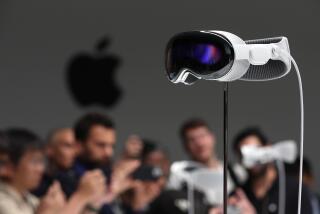Memo to Apple: Time for Some Fresh Ideas
- Share via
To: John A. Sculley
Chief Executive, Apple Computer
Subject: Revitalizing Apple
These are excruciating times for Apple and for you. Your market share in personal computers continues to decay, you’ve churned top management and on Wednesday announced a 3% work force cut. Your leadership has been criticized as destructively aloof or low-key incompetent.
The merit of these criticisms is less important than the practical steps that you take to re-energize Apple with the discipline and direction you know it needs. Apple is an important company with the rare opportunity to become a great one. Don’t be introspective and look deep within Apple to rediscover its soul. Listen instead to your community of vendors, customers and, yes, competitors to learn what Apple can be.
Apple succeeded because it packaged new technology in ways that created excitement as well as value. From the click of a mouse to the hum of a laser printer, Apple defined personal computer innovation in the 1980s. The company didn’t just build products--it built markets. By offering systems that blended power and ease of use, Apple turned cynics into converts.
That is no longer true. The only area where Apple is undisputed industry leader is intellectual property litigation. Today’s Apple seems more interested in selling expensive computers than in creating value. The result is the mess Apple now finds itself in.
These suggestions, culled from the Apple community, offer constructive ways to clean up that mess. Please take them in the spirit in which they are intended.
*Mea culpa. As a high-profile statesman of the industry (with a best-selling business autobiography), you have rightfully been identified with Apple’s many successes. Now that times are unpleasant, the single most important step you can take is to openly accept responsibility for Apple’s current confusion. Confession isn’t just good for the soul, it also does wonders for one’s credibility. It will also be easier to remedy Apple’s weaknesses if you acknowledge your own.
* Discover humility. A lot of Apple’s thirtysomething MBAs behave as if they are God’s gift to computerdom--an irritating blend of insolence, arrogance and ignorance. Gather them and tell them that the average Apple employee is as arrogant as the average journalist--not a healthy state of affairs. But although journalists at least are forced to talk with outsiders, Apple--like the computers it builds--has become increasingly insular. Your third-party vendors are treated like vassals Apple deigns to favor rather than genuine partners in development.
Apple must eliminate this “image of arrogance,” asserts Andrea Cunningham, a marketing consultant who has worked extensively with Silicon Valley firms, including Apple. Get key third-party vendors and their Apple managers together in a room with you and make it clear to everyone that Apple wants to build symbiotic relationships. Tell your managers to empower Apple’s partners, not just cut the best deal for Apple. Get rid of the joke that “You can tell an Apple MBA--but you can’t tell him much.”
Apple needs to make other fundamental culture changes. “It seems that Apple values only two things: whizzy engineering and cool marketing,” says Guy Kawasaki, a former Apple software “evangelist.” This lures the company into viewing both technology and marketing as gimmicks rather than as media to build ongoing customer relationships.
* Exploit the low end. Externally, perhaps the single most important question you have to ask yourself is: What are the two most compelling reasons today to buy a Macintosh? Your dealers have trouble answering this. Even Apple insiders sputter, stutter and hesitate. IBM and its PC clonesters can get away with being “the safe choice.” You can’t.
Apple obviously isn’t competing on price. But do you honestly believe that today’s Macintoshes deserve the same premium they did three years ago? A company like Apple is very much the creature of the technologies it creates. Once upon a time, those technologies were radically easier to use, a clear difference and an intoxicating blend of power and functionality. Today, they are but faster and better extensions of what you did yesterday. As your sales figures show, that’s not good enough. Apple no longer defines the leading edge of technology. Buy time until Apple can recapture that edge.
Because Apple’s franchise is ease of use, you are superbly positioned to develop the low (read cheap ) end of the personal computer market, points out David Liddle, president of Metaphor, a high-end software systems firm. Liddle and other Silicon Valley gurus believe that a low-end Mac would capture a whole new generation of users, rekindle third-party efforts and generate greater awareness.
“Apple’s biggest competition isn’t IBM or Compaq,” says Kawasaki. “It’s ignorance.” Exactly so. So make the Mac more available. The most provocative suggestion comes from one of your biggest dealers. “License Sony to make a low-end Mac based on Motorola’s 68020 chip,” says Martin Mazner, executive vice president of sales and marketing at Palo Alto-based ComputerWare, “and tell them to make it the No. 1 computer in the world. That would be a wonderful thing.” Apple gets a superb-quality, low-cost Mac, royalties--and preserves its high-end proprietary base. Apple needs that sort of bold stroke.
* Redefine the Mac’s value. In fact, the Mac needs to be entirely repositioned. Ad campaigns such as “desktop media” and that silly “helocar” are conceptually hollow. People should know that there’s more to a Mac than graphics.
The market has also moved on. Personal computing is yielding to interpersonal computing. Position yourself accordingly. Most people today work in groups. Why not show an ad with a network of people working with Macintoshes along with the tag line “The Power to Be Our Best” instead of “The Power to Be Your Best”?
Similarly, the Mac only co-exists in today’s corporate computer networks--it doesn’t enhance them. Apple needs a network strategy and the technology to go with it. Let’s see tools that turn Mac screens into a new window--a new lens--to provide unique views of the corporate database, views we can’t get from IBMs and Compaqs.
Market the Mac as both a tool and a gateway--not just a computer that is easier to use than the competition. Remember, Apple brilliantly exploited and harnessed the desktop publishing market through its masterful linkage of Mac and LaserWriter.
With desktop publishing, Apple wasn’t just selling a computer--it was selling a system. But note that Apple was using the peripheral--the laser printer--to redefine the role of the Mac. You should strongly consider using peripherals--scanners, modems, large screen displays, 35-mm slide generators, television sets, etc.--as ways to redefine and enhance the value of the Mac. The Mac is a wonderful tool. Surround it with technologies that underscore just how wonderful it is.
“Being the best of breed isn’t enough,” asserts Metaphor’s Liddle. “Apple needs to have broader suites of interoperable tools and . . . get companies to build blocks of these tools.” In other words, the Mac needs to become less of a “computer technology” and more of an environment for people. Market the Mac as the system that best captures the emerging ecology of media and information--and get your suppliers to buy in.
* Invest. Apple is now sitting on more than $900 million in cash--real money--you can afford to invest in anything you want. Metaphor’s Liddle suggests that you might want to acquire “a company like 3 Com”--a computer networking firm. Maybe you want to spend more on R&D; or marketing. The fact that you aren’t investing the money seems to signal that you don’t really know what you want to do with it. How you choose to invest it may be the important signal you send because it will reveal your priorities.
I’ve consulted (briefly) for Apple and found that people there are enthusiastic, intelligent and excited. Apple would be better off if your people were equally enthusiastic and excited about what its customers and third-party vendors were doing. The issue isn’t “giving customers what they want”--it’s putting them in a position to cost-effectively realize everything that Apple’s technology can do for them. I have no doubt that you can revitalize Apple’s technical edge--but my hope is that you can build an organization that cares as much about the people who use Apple’s innovations as the innovations themselves.






